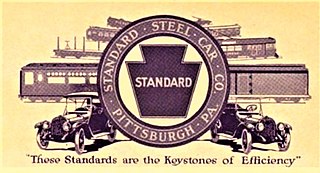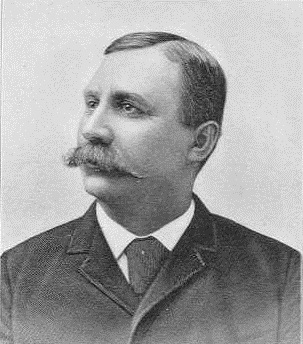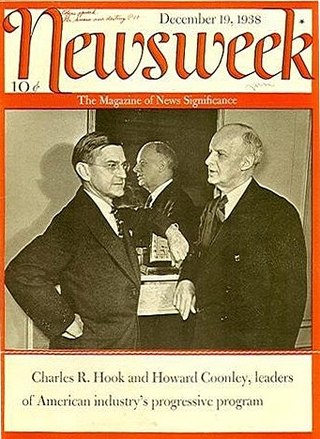
New Miami is a village in St. Clair Township, located in central Butler County in the southwestern part of the U.S. state of Ohio. The population was 2,217 at the 2020 census.

A steel mill or steelworks is an industrial plant for the manufacture of steel. It may be an integrated steel works carrying out all steps of steelmaking from smelting iron ore to rolled product, but may also be a plant where steel semi-finished casting products are made from molten pig iron or from scrap.
Continuous production is a flow production method used to manufacture, produce, or process materials without interruption. Continuous production is called a continuous process or a continuous flow process because the materials, either dry bulk or fluids that are being processed are continuously in motion, undergoing chemical reactions or subject to mechanical or heat treatment. Continuous processing is contrasted with batch production.

The Standard Steel Car Company (SSC) was a manufacturer of railroad rolling stock in the United States that existed between 1902 and 1934.
Tinplate consists of sheets of steel coated with a thin layer of tin to impede rusting. Before the advent of cheap milled steel, the backing metal was wrought iron. While once more widely used, the primary use of tinplate now is the manufacture of tin cans.

In metalworking, rolling is a metal forming process in which metal stock is passed through one or more pairs of rolls to reduce the thickness, to make the thickness uniform, and/or to impart a desired mechanical property. The concept is similar to the rolling of dough. Rolling is classified according to the temperature of the metal rolled. If the temperature of the metal is above its recrystallization temperature, then the process is known as hot rolling. If the temperature of the metal is below its recrystallization temperature, the process is known as cold rolling. In terms of usage, hot rolling processes more tonnage than any other manufacturing process, and cold rolling processes the most tonnage out of all cold working processes. Roll stands holding pairs of rolls are grouped together into rolling mills that can quickly process metal, typically steel, into products such as structural steel, bar stock, and rails. Most steel mills have rolling mill divisions that convert the semi-finished casting products into finished products.

AK Steel Holdings Corporation was an American steelmaking company headquartered in West Chester Township, Ohio. The company, whose name was derived from the initials of Armco, its predecessor company, and Kawasaki Steel Corporation, was acquired by Cleveland-Cliffs in 2020.

Tadeusz Sendzimir was a Polish engineer and inventor of international renown. He held 120 patents in mining and metallurgy, 73 of which were awarded to him in the United States.

Paul John Sorg was a businessman and member of the United States House of Representatives from Ohio from 1894 to 1897.
Ashland is a city in north-eastern Kentucky. Prior to European colonization, it was home to the Adena culture, Hopewell culture, Armstrong culture, and Fort Ancient Native American groups, and later the Shawnee. European settlement by Scots-Irish Americans began in 1783. In 1800, iron deposits were discovered in Ashland, which would lead to an influx of industry over the next two centuries. In the 21st century, city growth has spilled into neighboring areas, technically outside of city-limits, and the industrial economy has shrunk alongside expansions in the services sector.

Steel, Peech and Tozer was a large steel maker with works situated at Ickles and Templeborough, in Rotherham, South Yorkshire, England.

The John B. Tytus House is a historic house at 300 South Main Street in Middletown, Ohio, United States. Built in 1865,it was the home of John Butler Tytus (1875-1944), who invented a practical hot wide-strip continuous steel-rolling process that transformed the American steelmaking industry. The house was designated a National Historic Landmark in 1976 due to the efforts of Jeri and Pat Rossi, who bought the house in 1970. The house was the residence of the Rossi family until 2011.

Harry Holiday, Jr. was a world record holder in the backstroke at the University of Michigan in the 1940s and the president of steelmaker American Rolling Mill Co. (Armco) from 1974 to 1986.

JSW Ispat Steel Ltd (JISL) was an Indian company with operations in iron, steel, mining, energy and infrastructure. It was set up as Nippon Denro Ispat Limited in May 1984 by founding chairman M. L. Mittal. It was listed on the Bombay Stock Exchange and National Stock Exchange of India until 2013 when it was merged with JSW Steel. It was headquartered in Mumbai and employed about 3,000 people.

Robert Woolston Hunt was an American metallurgical engineer, inventor, and superintendent in the steel industry. He is known as president of the American Institute of Mining Engineers in 1883 and 1906; president of the American Society of Mechanical Engineers in the year 1891–92; and president of the Western Society of Engineers in 1893.
Primetals Technologies Limited, is an engineering and plant construction company headquartered in London, United Kingdom, with numerous locations worldwide. It serves clients in the metals industry, both the ferrous and the nonferrous metals sector. It was established as a joint venture between Siemens VAI Metals Technologies and Mitsubishi-Hitachi Metals Machinery in 2015. As of 2020, Primetals Technologies is a joint venture of Mitsubishi Heavy Industries and partners.

Charles Hill Morgan was an American mechanical engineer, inventor, industrialist and President of the American Society of Mechanical Engineers in the year 1900–01. He is known for his contributions to Worcester and to the steel industry, especially to rod rolling.

Charles Ruffin Hook Sr. was an American industrialist, second president of Armco Steel Corp., and recipient of the Henry Laurence Gantt Medal in 1950.

The Overpeck Cutoff is a railroad line is currently owned by CSX Transportation in the U.S. State of Ohio. The line runs from Overpeck Junction in Overpeck, Ohio to HM Junction in Woodsdale, Ohio. This forms a wye diverging off the Toledo Subdivision in Overpeck, Ohio at Overpeck Junction and meeting the Middletown Subdivision at HM Junction.

Steel: Armco, Middletown, Ohio is a black and white photograph taken by American photographer Edward Weston in 1922.
















